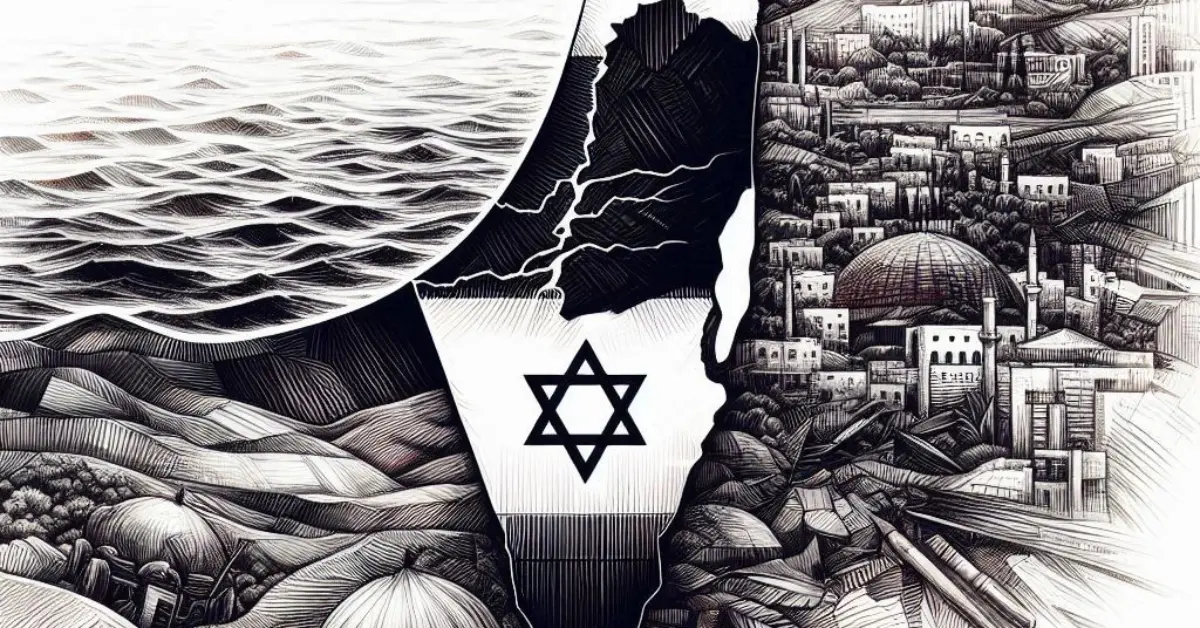The Israel-Palestine conflict is one of the most enduring and complex geopolitical issues of our time, spanning over a century.
This comprehensive overview aims to provide a detailed understanding of the conflict’s historical roots, key issues, and current state.
Historical Origins
The roots of the conflict can be traced back to the late 19th and early 20th centuries with the emergence of Zionism and Arab nationalism.
| Movement | Description | Key Figures/Events |
|---|---|---|
| Zionism | Movement supporting the establishment of a Jewish state in historic Israel/Palestine | Nathan Birnbaum (coined term in 1885), Theodor Herzl (“The Jewish State”, 1896) |
| Arab Nationalism | Movement aiming to unify Arab people under a single political and cultural identity | George Antonius (“The Arab Awakening”, 1938) |
Key Events and Developments
| Year | Event | Significance |
|---|---|---|
| 1882 | First Aliyah | Initial wave of Jewish immigration to Palestine |
| 1917 | Balfour Declaration | British support for “national home for the Jewish people” in Palestine |
| 1920-1948 | British Mandate period | British governance of Palestine |
| 1936-1939 | Arab Revolt | Palestinian uprising against British rule and Jewish immigration |
| 1947 | UN Partition Plan | Proposal to divide Palestine into Jewish and Arab states |
| 1948 | Israeli Declaration of Independence; Arab-Israeli War | Establishment of Israel; Palestinian exodus (Nakba) |
| 1967 | Six-Day War | Israeli occupation of West Bank, East Jerusalem, Gaza Strip, and Golan Heights |
| 1987-1993 | First Intifada | Palestinian uprising against Israeli occupation |
| 1993-1995 | Oslo Accords | Establishment of Palestinian Authority |
| 2000-2005 | Second Intifada | Breakdown of peace process; construction of Israeli West Bank barrier |
| 2005 | Israeli disengagement from Gaza | Withdrawal of Israeli settlers and military from Gaza Strip |
| 2006 | Hamas wins Palestinian legislative elections | Political division between Hamas-controlled Gaza and Fatah-controlled West Bank |
| 2008, 2012, 2014 | Gaza Wars | Major conflicts between Israel and Hamas in Gaza |
| 2020 | Abraham Accords | Normalization agreements between Israel and several Arab nations |
Core Issues
| Issue | Description | Positions |
|---|---|---|
| Territory and Borders | Control and division of land | Israel: Secure borders, retention of some settlements Palestinians: Return to 1967 borders, East Jerusalem as capital |
| Jerusalem | Status of the city | Israel: Undivided capital of Israel Palestinians: East Jerusalem as capital of future state |
| Palestinian Refugees | Right of return for refugees and descendants | Palestinians: Demand right of return Israel: Concerns about demographic changes |
| Israeli Settlements | Jewish communities in occupied territories | Israel: Some seen as security necessity International community: Considered illegal under international law |
| Security | Protection from violence and threats | Israel: Concerns about terrorism and hostile neighbors Palestinians: End to military occupation |
Major Conflicts
| Conflict | Year(s) | Key Outcomes |
|---|---|---|
| Arab-Israeli War | 1948-1949 | Israeli independence; Palestinian exodus |
| Six-Day War | 1967 | Israeli occupation of West Bank, East Jerusalem, Gaza, Golan Heights |
| Yom Kippur War | 1973 | Shift in regional dynamics; eventual Israel-Egypt peace treaty |
| First Intifada | 1987-1993 | Increased international attention to Palestinian cause |
| Second Intifada | 2000-2005 | Breakdown of peace process; construction of separation barrier |
| Gaza Wars | 2008, 2012, 2014 | Significant casualties and destruction in Gaza |
| Israel-Gaza Conflict | 2021 | Renewed violence; international calls for ceasefire |
Peace Efforts
| Initiative | Year | Key Points | Outcome |
|---|---|---|---|
| Camp David Accords | 1978 | Framework for peace between Israel and Egypt | Successful; Israel-Egypt peace treaty signed in 1979 |
| Oslo Accords | 1993-1995 | Mutual recognition; establishment of Palestinian Authority | Initial progress, but ultimate failure to achieve final status agreement |
| Camp David Summit | 2000 | Attempted final status agreement | Failed to resolve key issues |
| Arab Peace Initiative | 2002 | Comprehensive peace plan proposed by Arab League | Not accepted by Israel, but remains on the table |
| Road Map for Peace | 2003 | Phased plan towards two-state solution | Implementation stalled |
| Annapolis Conference | 2007 | Relaunched peace negotiations | Failed to produce concrete results |
Current Situation
| Aspect | Description |
|---|---|
| West Bank | Partially occupied by Israel, partially controlled by Palestinian Authority |
| Gaza Strip | Controlled by Hamas, under blockade by Israel and Egypt |
| East Jerusalem | Annexed by Israel, not recognized internationally |
| Settlements | Continued expansion in West Bank and East Jerusalem |
| Violence | Sporadic outbreaks of conflict, particularly in Gaza |
| Political Division | Split between Fatah-led Palestinian Authority in West Bank and Hamas in Gaza |
International Involvement
| Actor | Role/Position |
|---|---|
| United Nations | Passes resolutions; provides humanitarian aid |
| United States | Historically main mediator; provides military aid to Israel |
| European Union | Provides economic aid; supports two-state solution |
| Arab League | Supports Palestinian cause; some members normalizing relations with Israel |
| Russia | Involved in peace negotiations; maintains relations with both sides |
| Iran | Supports Palestinian militant groups, particularly Hamas and Islamic Jihad |
Humanitarian Impact
| Issue | Impact |
|---|---|
| Casualties | Thousands of lives lost on both sides over decades |
| Displacement | Millions of Palestinian refugees and internally displaced persons |
| Economic Hardship | High unemployment and poverty rates, particularly in Gaza |
| Restricted Movement | Checkpoints and barriers limit Palestinian movement |
| Mental Health | Widespread trauma and psychological impact on both populations |
| Infrastructure Damage | Repeated conflicts have damaged homes, schools, and essential services |
Recent Developments and Future Prospects
| Development | Year | Potential Impact |
|---|---|---|
| Abraham Accords | 2020 | Normalization of relations between Israel and some Arab states; potential shift in regional dynamics |
| Continued Settlement Expansion | Ongoing | Complicates prospects for territorial compromise |
| Gaza Reconstruction | Ongoing | Potential to improve humanitarian situation, but tied to political developments |
| International Diplomatic Efforts | Ongoing | Continued attempts to revive peace process and two-state solution |
Conclusion
The Israel-Palestine conflict remains one of the most challenging and complex issues in international relations. Its resolution requires addressing deeply rooted historical, territorial, and identity-based disputes. While peace efforts have made some progress, a comprehensive solution remains elusive. Understanding the multifaceted nature of this conflict is crucial for comprehending its impact on regional and global politics, as well as the lives of millions of people in the region.
As students of this topic, it’s important to approach the issue with an open mind, considering multiple perspectives and the complex interplay of historical, political, and cultural factors that continue to shape this enduring conflict. The path to peace remains challenging, but various diplomatic initiatives, international mediation efforts, and grassroots movements persist in seeking a resolution that can provide security and self-determination for both Israelis and Palestinians.



